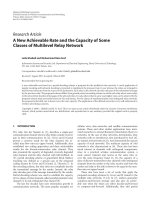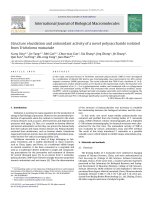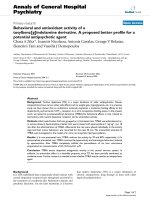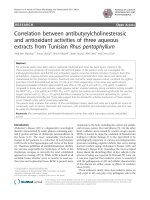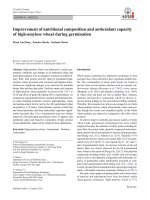Phytochemical and antioxidant capacity of traditional rice varieties of Karnataka, India
Bạn đang xem bản rút gọn của tài liệu. Xem và tải ngay bản đầy đủ của tài liệu tại đây (0 B, 9 trang )
Int.J.Curr.Microbiol.App.Sci (2020) 9(5): 67-75
International Journal of Current Microbiology and Applied Sciences
ISSN: 2319-7706 Volume 9 Number 5 (2020)
Journal homepage:
Original Research Article
/>
Phytochemical and Antioxidant Capacity of
Traditional Rice Varieties of Karnataka, India
Gopika C. Muttagi* and Usha Ravindra
Department of Food Science and Nutrition, UAS, GKVK, Bengaluru, India
*Corresponding author
ABSTRACT
Keywords
Traditional rice
varieties,
phytochemical,
antioxidant
Article Info
Accepted:
05 April 2020
Available Online:
10 May 2020
Evaluation of twenty traditional rice varieties grown in Karnataka, as a
dehusked grain was performed with respect to Phytochemical and
Antioxidant capacity. Traditional rice varieties varied significantly (p<0.05)
for all the parameters studied. Phytochemicals namely, phytic acid, tannic
acid and total polyphenol content were studied in twenty traditional rice
varieties varied significantly (p<0.05) from 236.94 to 558.67 mg, 25.74 to
56.88 mgGAE, and 47.82 to 160.71 mg per 100 g respectively. Total
antioxidant capacity varied significantly from 257.93 µM to 800.25 µM
ascorbic acid equivalent per 100 g. Traditional rice varieties contained good
amount of phytochemicals and antioxidant activity which are helpful in
maintaining good health and wellness.
increased awareness about its health benefits
and good nutritional properties due to higher
amounts of proteins, ash, dietary fibre and
minerals than white rice (Tan et al., 2009;
Mohan et al., 2010; USDA, 2010).
Introduction
Rice (Oryza sativa L.) is one of the major
food crops in the world and more than 50 per
cent of the world’s population depend on rice
as their primary calorie source (FAO, 2001)
and increasingly becoming popular because of
its nutritional and beneficial health properties
(Saikia et al., 2012). Commonly, rice is
consumed as polished white rice with the
husk, bran, and germ fractions removed.
However, consumption of brown rice (hulled
rice) is increasing in recent years, due to the
Rice bran contains high amounts of protein,
fiber, minerals, vitamins, phytochemicals,
bioactive
molecules,
tocopherols,
tocotrienols, oryzanols and other phenolic
compounds (Yokoyama, 2004; Wanyo et al.,
2009; Mohan et al., 2010; Zhu et al., 2010;
Min et al., 2011). Phytochemical’s functions
67
Int.J.Curr.Microbiol.App.Sci (2020) 9(5): 67-75
include free radical scavenging, antioxidant
activity, enhancement of immune systems,
and reduction of the risk of developing heart
disease and cancer (Qureshi et al., 2000; Xu
et al., 2001). Through the introduction of
modern high yielding varieties, along with
new management practices and green
revolution has led to a considerable increase
in rice production in India as in other Asian
countries. This development has led to a
gradual erosion of the rice genetic diversity,
since thousands of traditional rice varieties
were replaced by relatively few high yielding
rice varieties (Rahman et al., 2006).
Materials and Methods
Procurement of traditional paddy rice
varieties
Twenty traditional rice varieties procured
from All India Coordinated Research Project
on Rice, ZARS, V. C. Farm, Mandya,
Karnataka were included in this study. The
different genotypes used for the study are,
Gamnad batta, Anandi, Krishnaleela,
Kagisaale, Murakan sanna, Mysore mallige,
Nagabatta, Gajagunda, Doddabyranellu,
Ratnachoodi, Malgudi sanna, Gowrisanna,
Chinna ponni, Salem sanna, Karimundaga,
Rajmudi,
Rajakaime,
Jeerige
sanna,
Gandhasaale, Kalajeera.
Traditional rice varieties have long been
consumed in Asian countries e.g., India, Sri
Lanka, China, Japan, etc. (Ahuja et al., 2007;
Finocchiaro et al., 2007; Finocchiaro et al.,
2010). Being a major cereal grain, evaluating
the nutritional composition of rice has been
given highest priority (Dong et al., 2007).
Rice grain quality is reported to be influenced
by various physico-chemical and cooking
characteristics (Bocevska et al., 2009;
Moongngarm, 2010). Providing adequate
information on the quality of rice consumed
by local population is important for health
conscious consumer. Variety with best grain
properties remains the most important
determinant of market grading and end use
qualities. However, studies have not been
carried
out
comprehensively
on
phytochemical and antioxidant capacity of the
traditional rice varieties in Karnataka, India.
Milling of paddy varieties
Paddy samples were cleaned thoroughly using
winnower to remove the chaff and other
foreign matters and dried in hot air oven up to
12-14 % moisture content and de-husked
using a rubber roll paddy sheller at the
Department of Post-harvest Technology,
UAS, GKVK, Bengaluru. Milling fractions
include husk, head rice, bran, and broken rice.
Only whole rice grains without any physical
damage or insect infestation were selected for
study purpose. Further, rice samples (head
rice without polishing) were individually
ground to a fine powder (60 mesh size),
packed in air tight polyethylene plastic bags
and were stored at 4 °C until further analysis.
To encourage traditional rice cultivation in
India, there is need for a systematic study that
would reveal nutritional qualities from
traditional rice varieties and would stand the
world market competitiveness. Thus keeping
in view of above facts the present research
work was undertaken with the objective to
analyse phytochemical and antioxidant
capacity of traditional rice varieties of
Karnataka.
Rice grain classification
Milled rice was first classified into three
categories based on length, long (>6 mm),
medium (5-6 mm), and short (<5 mm). They
were again classified into three groups based
on the length/breadth ratio; slender (>3); bold
(2-3); round (<2) to determine size and shape
(IRRI, 1993).
68
Int.J.Curr.Microbiol.App.Sci (2020) 9(5): 67-75
Estimation
of
phytochemical
antioxidant capacity
acid was taken as substrate. Various
concentrations of ascorbic acid were prepared
and added to DPPH solution. The decrease in
O.D is plotted against concentration of
ascorbic acid. The concentration of sample
was calculated using the standard curve
(Brand-Williams et al., 1995).
and
The pytochemicals such as phytic acid,
tannin, total polyphenol content, and
antioxidant activity were estimated. The
methods adopted for phytochemicals analysis
are as follows.
Results and Discussion
Estimation of phytic acid
Phytochemical
composition
antioxidant capacity
The estimation of phytic acid was based on
the principle that the phytate is extracted with
trichloroacetic acid and precipitated as ferric
salt. The iron content of the precipitate was
determined colorimetrically and the phytate
phosphorous content calculated from this
value assuming a constant 4 Fe: 6 molecular
ratios in the precipitate. Phytates were
estimated as phytic acid (Sadashivam and
Manickam, 1991).
and
Phytochemicals viz., phytic acid, tannic acid
and total polyphenol content that were studied
in twenty traditional rice varieties are reported
in Table 1. Total antioxidant capacity (TAC)
expressed by ascorbic acid equivalent (AAE)
in long, medium and short grain rice varieties
are also presented in Fig. 1. The relationship
between TAC and TPC is depicted in Fig 2.
Estimation of tannin (AOAC, 1980)
Phytic acid (per 100g)
Tannin was estimated colorimetrically based
on the measurement of blue colour formed by
the reaction of phosphotungstomolybdate acid
in alkali solution.
The twenty rice varieties tested had a large
variation in contents of phytic acid and
statistically significant differences (p<0.05)
were observed between the rice varieties.
Irrespective of grain category, the amount of
phytic acid content ranged between 236.94
and 558.67 mg per 100g. Among long grain
rice varieties Krishnaleela (540.62 mg)
reported the highest phytic acid followed by
Gajagunda (543.42) with no significant
difference while least value was recorded in
Anandi (250.50 mg).
Estimation of total polyphenols
Blue colour developed by polyphenols with
FCR reagent in alkaline condition was
measured at 650 nm (Sadasivam and
Manickam, 1991).
Total
polyphenol
(mg/100g)
=
Concentration of
polyphenol from
graph
Aliquot taken for
estimation
5
Among medium and short grain rice varieties,
Doddabyranellu (558.67 mg) and Kalajeera
(348.78 mg) recorded higher level of phytic
acid while least was observed in Chinna ponni
(236.94 mg) and Rajakaime (264.90 mg)
respectively.
Overall,
Doddabyranellu
(558.67 mg) had highest phytic acid content
and least was in Chinna ponni (236.94 mg).
X
Wt. of
sample
Estimation of antioxidant activity by DPPH
method
The antioxidant activity was expressed in
terms of ascorbic acid equivalents, so ascorbic
69
Int.J.Curr.Microbiol.App.Sci (2020) 9(5): 67-75
The variation in phytic acid among traditional
rice varieties probably due to differences of
cultivating environments and agricultural
practices (Liu, 2004). In this study,
Doddabyranellu (558.67 mg) had highest
phytic acid content and least was in Chinna
ponni (236.94 mg) among all the traditional
rice varieties. Liang et al., (2008) reported
that phytic acid levels in brown rice ranged
from 7.8 and 11.1 g per kg and decreased with
prolonged milling.
Total polyphenol content (GAE per 100g))
Phenolic compounds are one of the major and
most complex groups of phytochemicals in
cereal grain. Great interest has been shown in
the polyphenols in rice for their multiple
biological activities. Total polyphenol content
(TPC) expressed in terms of gallic acid
equivalent (GAE) per 100g of rice was found
significantly (p<0.05) highest in Gajagunda
(152.33 mg) and lowest was observed in
Nagabatta (47.82 mg) among long grain rice
varieties.
However, phytic acid levels in milled rice
ranged from 0.2 to 9.0 g per kg. These results
are in agreement with Almana (2000) who
reported that, the lower phytate content of
milled rice was due to the separation of bran
layer and aleurone layer of the kernel. In this
study, lower values of phytic acid were
observed. However phytic acid values are
comparable with the values reported by
Shallan et al., (2010).
Karimundaga (160.71 mg) a medium grain
rice variety showed significantly highest TPC
among all the varieties tested. TPC ranged
between 55.27 and 82.79 mg in short grain
rice varieties. The total phenolics reported by
Shao et al., (2014) in fully matured white, red
and black rice ranged between 30.69 to
156.83 mg GAE per 100 g rice.
Tannic acid (per 100g)
Total antioxidant capacity (AAE per 100g)
Tannic acid is a type of polyphenol. The
means of tannic acid differed significantly
(p<0.05) among long grain rice varieties, the
lowest values being found in the Gamnad
batta (25.74 mg) and the highest in Gajagunda
(54.13 mg). Medium grain rice varieties
ranged from 29.98 mg (Chinna ponni) to
56.88 mg (Karimundaga) for tannic acid and
28.65 mg (Kalajeera) to 42.29 mg
(Rajakaime) in short grain rice varieties.
The beneficial effects originating from
phenolic compounds can be a major
determinant of antioxidant activities in many
edible sources (Lee et al., 2005). The results
clearly showed that traditional rice varieties
possessed significantly (p<0.05) higher
antioxidant capacity and great variations in all
the tested rice varieties (Fig 1). Among long
grain rice varieties, it ranged between 257.93
µM (Nagabatta) and 703.76 µM (Gajagunda).
Irrespective of grain type, Karimundaga
(56.88 mg) recorded maximum tannic acid,
whereas Gamnad batta (25.74 mg) recorded
minimum. The results obtained in the present
study are in accordance with the values
reported by Trinidad et al., (2009). In their
study, tannic acid contents in brown rice (56.9
± 3.2 mg/100 g) was significantly higher than
milled rice (21.3 ± 2.3 mg/100 g, P<0.05).
Whereas in medium and short grain rice
varieties, it varied from 342.58 µM (Malgudi
sanna) to 800.25 µM (Karimundaga) and
275.44 µM (Rajakaime) to 431.83 µM
(Jeerige sanna) of rice respectively.
Irrespective of grain type, total antioxidant
capacity recorded highest in Karimundaga
(800.25 µM) and least was in Nagabatta
(257.93 µM).
70
Int.J.Curr.Microbiol.App.Sci (2020) 9(5): 67-75
Table.1 Phytochemical composition and antioxidant capacity of traditional rice varieties
Category
No.
Varieties
Long
grain
1
2
3
4
5
6
7
8
9
10
11
12
13
14
15
16
17
18
19
20
Gamnad batta
Anandi
Krishnaleela
Kagisaale
Murakan sanna
Mysore mallige
Nagabatta
Gajagunda
Doddabyranellu
Ratnachoodi
Malgudi sanna
Gowrisanna
Chinna ponni
Salem sanna
Karimundaga
Rajmudi
Rajakaime
Jeerige sanna
Gandhasaale
Kalajeera
F test
SEm±
CD at 5 %
Medium
grain
Short
grain
Phytic acid
(mg/100g)
380.24i
250.50p
540.62b
324.95l
430.13h
468.66g
290.74n
543.42b
558.67a
500.50d
500.37d
490.35e
236.94q
288.12n
507.49c
478.30f
264.90o
319.60m
329.94k
348.78j
*
1.614
4.475
Tannic acid
(mg/100g)
25.74i
28.63hi
43.20bcd
37.44def
36.39ef
29.09ghi
33.58fgh
54.13a
55.26a
44.33bc
47.57b
33.26fgh
29.98ghi
37.12def
56.88a
38.30cdef
42.29bcde
35.31fg
34.17fgh
28.65hi
*
2.237
6.202
* Significant at 5 % level
Note: Means in the same column followed by different superscript letters differ significantly
71
Total polyphenol
content
(mg GAE/100g)
57.71q
78.16m
147.45d
98.16f
84.26i
90.16h
47.82s
152.33c
156.72b
91.87g
77.68m
80.32l
112.65e
71.57o
160.71a
81.41k
55.27r
82.79j
62.52p
73.52n
*
0.323
0.894
Total antioxidant
capacity
(µM AAE/100g)
298.05r
361.80m
653.98d
622.55e
459.07i
485.71h
257.93t
703.76c
750.06b
514.99g
342.58o
398.38l
574.45f
354.75n
800.25a
415.39k
275.44s
431.83j
313.13q
332.18p
*
0.489
1.356
Int.J.Curr.Microbiol.App.Sci (2020) 9(5): 67-75
Fig.1 Total polyphenol content (TPC) and total antioxidant capacity (TAC) of traditional
rice varieties
Fig.2 Relationship between total polyphenol content (TPC) and total antioxidant capacity
(TAC) of traditional rice varieties
72
Int.J.Curr.Microbiol.App.Sci (2020) 9(5): 67-75
Dutta et al., (2012) reported total antioxidant
capacity in methanolic extracts of ten high
yielding rice varieties of Bangladesh ranged
from 297.04 to 701.16 µM AAE per 100 g of
dry weight of rice flour. Similar results were
obtained in the present study and clearly
showed that traditional rice varieties
possessed significantly (p<0.05) higher
antioxidant capacity expressed in terms of
ascorbic acid equivalent (AAE). This may be
due to minimal processing and polishing
followed for these rice samples and also
genetic inheritance of quality of traditional
rice varieties making them more preferred
over high yielding varieties among the
populations.
and TAC was observed by Gunaratne et al.,
(2013) in traditional red grained rice varieties
of Sri Lanka. Many previous reports also
showed that phenolic compounds were major
antioxidant constituents in cereals, medicinal
herbs, vegetables, fruits, and spices (Liu,
2004; Shan et al., 2005; Cai et al., 2006; Shen
et al., 2009).
The results of this study demonstrated a wide
range of phytochemical composition and
antioxidant activity among traditional rice
varieties, which provided the basic
information for future development of food
applications using these varieties. Traditional
rice varieties are better source of
phytochemicals
and
antioxidants.
Phytochemicals namely, phytic acid, tannic
acid and total polyphenol content were
studied in twenty traditional rice varieties
varied significantly (p<0.05) from 236.94 to
558.67 mg, 25.74 to 56.88 mgGAE, and 47.82
to 160.71 mg per 100 g respectively. The
results in this study clearly showed that
traditional
rice
varieties
possessed
significantly (p<0.05) higher antioxidant
capacity expressed in terms of ascorbic acid
equivalent (AAE). Hence there is a need to
popularize these varieties through enhanced
production and processing, so that common
man can consume phytochemical rich food to
get better nutrition.
Relationship between total polyphenol
content (TPC) and total antioxidant
capacity (TAC)
The regression analysis was done to quantify
the relationship between TPC and TAC by
plotting scatter diagram and linear regression
line (Fig. 2). The regression equation for the
linear model was y = 4.588x + 39.85. The
final model has used ‘x’ (TPC) as the
predictor variable and ‘y’ (TAC) as explained
variable. The coefficient or slope is 4.588,
which indicates that, for every unit of TPC,
the TAC increases on average by 4.588
points. The value of R2 = 0.931 which means
the model is adequate. It is evident from the
findings that 93.1 per cent of the variation in
TAC is explained by TPC.
References
Ahuja, U., Ahuja, S. C., Chaudhary, N., and
Thakrar, R. 2007. Red rices – Past,
present and future. Asian Agri. History.
11, 291–304.
Almana, H. A., 2000. Extent of phytate
degradation in breads and various foods
consumed in Saudi Arabia. Food Chem.
70, 451-456.
Bocevska, M., Aldabas, I., Andreevska, D.
and Ilieva, V. 2009. Gelatinization
behaviour of grains and flour in relation
The correlative analysis was also done in this
study and a highly positive correlation (r =
0.965**, p<0.01) between TPC and TAC
values of the tested traditional rice varieties
was established, clearly indicating that the
higher TPC value resulted in higher TAC
value. This suggested that, the phenolic
compounds in the tested rice varieties were
largely responsible for their total antioxidant
capacity. Similar association between TPC
73
Int.J.Curr.Microbiol.App.Sci (2020) 9(5): 67-75
to physiochemical properties of milled
rice (Oryza Sativa L.). J. Food Quality.
32, 108-124.
Brand-Williams, W., Cuvelier, M. E. and
Berset, C. 1995. Use of a free radical
method to evaluate antioxidant activity.
Food Sci. Technol. 28, 25–30.
Cai, Y. Z., Sun, M., Xing, J., Luo, Q., and
Corke, H. 2006. Structure-radical
scavenging activity relationships of
natural phenolic compounds from
traditional Chinese medicinal plants.
Life Sci. 78, 2872–2888.
Dong, M. H., Sang, D. Z., Wang, P., Wang,
X. M. and Yang, J. C. 2007. Changes in
cooking and nutrition qualities of grains
at different positions in a rice panicle
under different nitrogen levels. Rice
Sci. 14, 141-148.
Dutta, A. K., Gope, P. S., Banik, S.,
Makhnoon, S., Siddiquee, M. A. and
Kabir, Y. 2012. Antioxidant properties
of ten high yielding rice varieties of
Bangladesh. Asia. Pac. J. Trop. Biomed.
18(2): 99-103.
FAO 2001. Specialty rices of the world. Food
and Agriculture Organization of the
United Nations, Rome, Italy.
Finocchiaro, F., Ferrari, B., Gianinetti, A.,
Dall’asta, C., Galaverna, G. and
Scazzina, F. 2007. Characterization of
antioxidant compounds of red and white
rice and changes in total antioxidant
capacity during processing. Molecular
Nutr. Food Res. 51, 1006–1019.
Finocchiaro, F., Ferrari, B., and Gianinetti, A.
2010. A study of biodiversity of
flavonoid content in the rice caryopsis
evidencing simultaneous accumulation
of anthocyanins and proanthocyanidins
in a black-grained genotype. J. Cereal
Sci. 51, 28–34.
Gunaratne, A., Wub, K., Li, D. C., Bentota,
A. D., Corke, H. B. and Cai, Y. 2013.
Antioxidant activity and nutritional
quality of traditional red-grained rice
varieties containing proanthocyanidins.
Food Chem. 138(3): 1153–1161.
IRRI (International Rice Research Institute).
1993. Grain structure, composition and
consumer’s criteria for quality. In: Rice
in human nutrition. Juliano, B. O., ed.
Food and Agriculture Organization of
the United Nations, Rome. 35-61.
Lee, B. W., Lee, J. H., Lee, S. T., Lee, H. S.,
Lee, W. S., Jeong, T. S. and Park K. H.
2005. Antioxidant and cytotoxic
activities of xanthones from Cudrania
tricuspidata Bioorg. Med. Chem. Lett.
15, 5548-5552.
Liang, J., Li, Z., Tsuji, K., Nakano, K., Nout,
M. J. R. and Hamer R. J. 2008. Milling
characteristics and distribution of phytic
acid and zinc in long, medium and short
grain rice. J. Cereal Sci. 48(1): 83-91.
Liu, R. H. 2004. Whole grain phytochemicals
and health. J. Cereal Sci. 46, 207–219.
Min, B., Mcclung, A. M. and Chen, M. H.
2011. Phytochemicals and antioxidant
capacities in rice brans of different
colour. J. Food Sci. 76(C): 117–C126.
Mohan, B. H., Malleshi, N. G.and KosekI, T.
2010. Physico-chemical characteristics
and non-starch polysaccharide contents
of indica and japonica brown rice and
their malts. Food Sci. Technol. 43(5):
784-791.
Moongngarm, A. 2010. Influence of
germination conditions on starch,
physicochemical
properties,
and
microscopic structure of rice flour.
International Conference on Biology
Env. Chem. IPCBEE. 1, 78-82.
Qureshi, A. A., Mo, H., PackeR, L. and
Peterson, D. M. 2000. Isolation and
identification of novel tocotrienols from
rice bran with hypocholesterolemic,
antioxidant, and antitumor properties. J.
Agri. Food Chem. 48, 3130-3140.
Rahman, S., Sharma, M. P. and Sahai, S.
2006. Nutritional and medicinal values
of some indigenous rice varieties.
74
Int.J.Curr.Microbiol.App.Sci (2020) 9(5): 67-75
Indian J. Tradit. Know. 5(4): 454-458.
Sadasivam, S. and Manickam, A. 1991.
Biochemical methods. Second edition.
New Age International Publishers.
Saikia, S., Dutta, H., Saikia, D. and Mahanta,
C. L. 2012. Quality characterization and
estimation of phytochemicals content
and antioxidant capacity of aromatic
pigmented and non-pigmented rice
varieties. Food Res. Int. 46(2): 334–
340.
Shallan, M. A., El-Beltagi, H. S., Mona, A.
M. and Amera, T. M. 2010. Chemical
evaluation of pre-germinated brown rice
and whole grain rice bread. Elec. J. Env.
Agricult. Food Chem. 9(5): 958-971.
Shan, B., Cai, Y. Z., Sun, M. and Corke, H.
2005. Antioxidant capacity of 26 spice
extracts and characterization of their
phenolic constituents. J. Agric. Food
Chem. 53. 7749–7759.
Shao, Y., Xu, F., Sun, X., Bao, J. and Beta, T.
2014. Phenolic acids, anthocyanins, and
antioxidant capacity in rice (Oryza
sativa L.) grains at four stages of
development after flowering. Food
Chem. 143(4): 90–96.
Shen, Y., Jin, L., Xiao, P., Lu, Y. and Bao, J.
S. 2009. Total phenolics, flavonoids,
antioxidant capacity in rice grain and
their relations to grain colour, size and
weight. J. Cereal Sci. 49(1): 106-111.
Tan, F., Dai, W. and Hsu, K. 2009. Changes
in gelatinization and rheological
characteristics of japonica rice starch
induced by pressure/heat combinations.
J. Cereal Sci. 49(2): 285-289.
Trinidad, T. P., Mallillin, A. C., Sagum, R. S.,
Briones, D. P., Encabo, R. R. and
Juliano, B. O. 2009. Iron absorption
from brown rice/brown rice-based meal
and milled rice/milled rice-based meal.
Int. J. Food Sci. Nutr. 60(8): 688-93.
USDA (United States Department of
Agriculture) Agricultural Research
Service. 2010. USDA nutrient database
for
standard
reference.
/>tm?docid=8964.u
Wanyo, P., Chommawang, C. and
Siriamornpun, S. 2009. Substitution of
wheat flour with rice flour and rice bran
in flake products: Effects on chemical,
physical and antioxidant properties.
World Appl. Sci. J. 7(1): 49-56.
Xu, Z., Hua, N. and Godber, J. S. 2001.
Antioxidant activity of tocopherols,
tocotrienols and γ-oryzanol components
from rice bran against cholesterol
oxidation accelerated by 2, 2-azobis (2methylpropionamidine)
dihydrochloride. J. Agric. Food Chem.
49: 2077–2081.
Yokoyama, W. 2004. Nutritional properties of
rice bran. In E. T. Champagne (Ed.), St.
Paul, MN: American Association of
Cereal Chemist. Rice Chem. Technol.
595–609.
Zhu, F., Cai, Y. Z., Bao, J., and Corke, H.
2010. Effect of γ-irradiation on phenolic
compounds in rice grain. Food Chem.
120, 74–77.
How to cite this article:
Gopika C. Muttagi and Usha Ravindra. 2020. Phytochemical and Antioxidant Capacity of
Traditional Rice Varieties of Karnataka, India. Int.J.Curr.Microbiol.App.Sci. 9(05): 67-75.
doi: />
75
